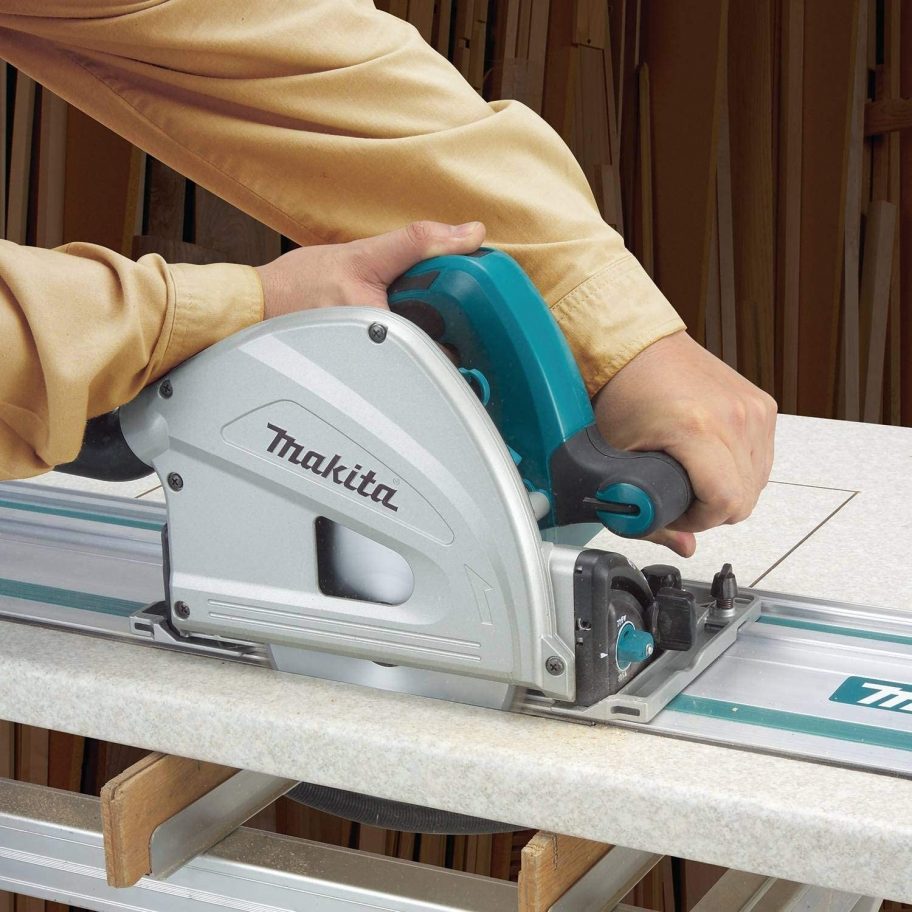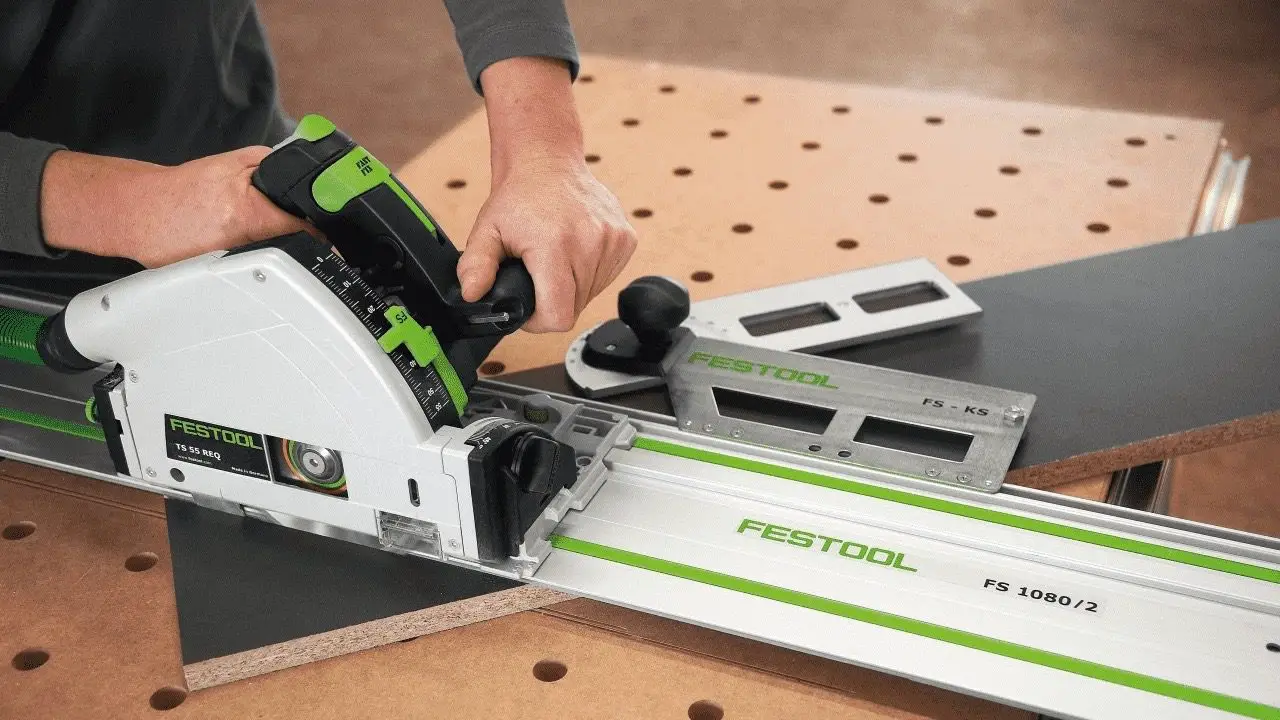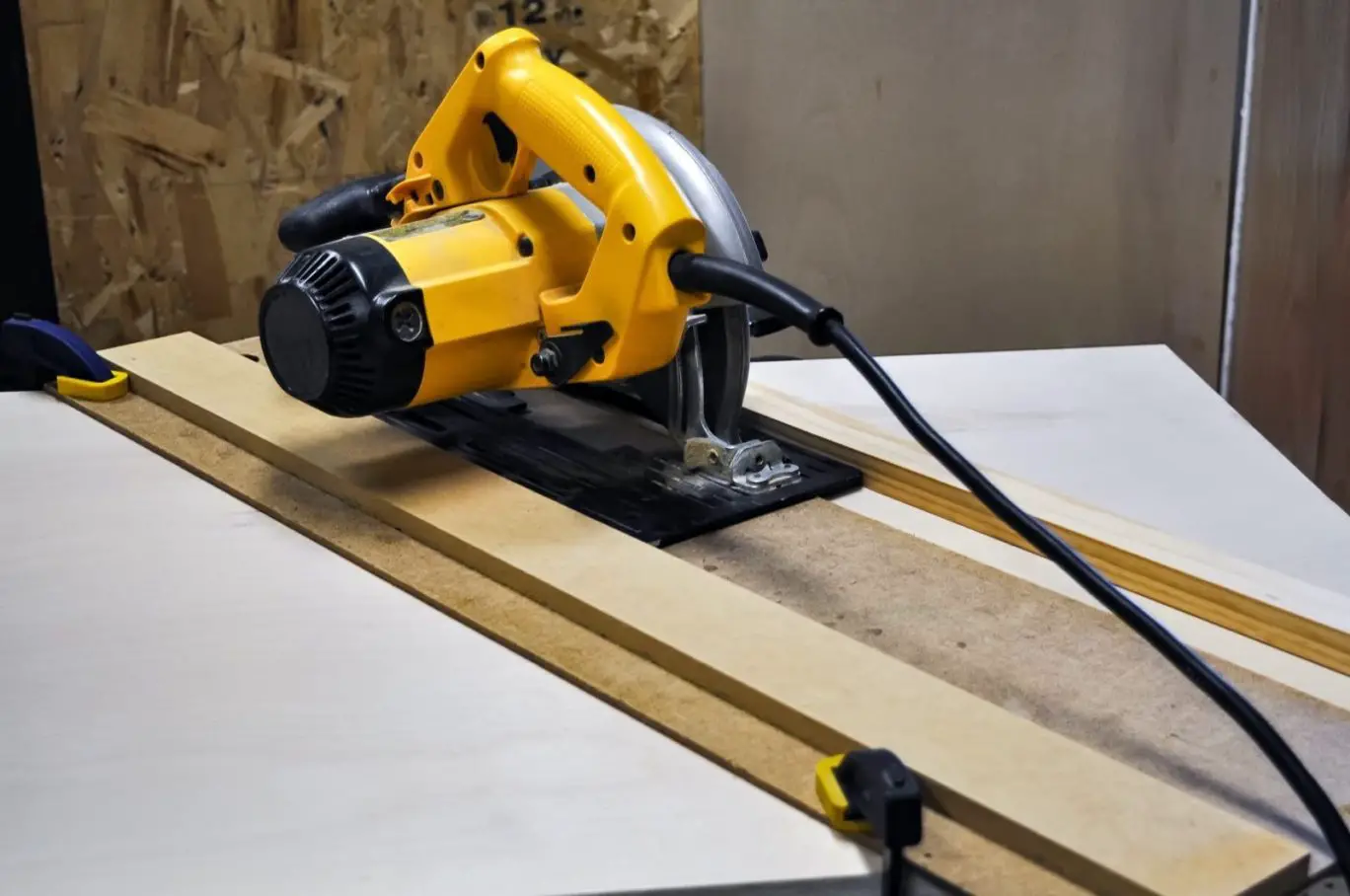Plenty of building tools have experienced a booming revolution in efficiency and technology in recent years. And track saws are definitely among the leaders in this industry. It’s no wonder woodworkers and DIYers desire to have such a power tool as an effective companion in every woodworking project.
However, many beginners have no idea how to use a track saw, resulting in poor outcomes in work. So, we’re here to offer you the most straightforward guide on using a track saw.
Our instruction includes seven easy steps to use a track saw properly:
- Choose the right materials
- Choose the blade
- Adjust cutting depth
- Activate the tool
- Wait for the proper blade speed
- Bear safety precautions in mind
- Use track rails
Besides, we’ll tell you everything about a track saw, from its benefits to the tips on how to buy an appropriate tool. Let’s dive into it!
What Is A Track Saw?

A track saw is a circular saw running on a precision metal rail or track. The saw features a compact design, hence an easy handheld operation.
This power tool allows ultra-accurate cutting along straight lines on wooden boards of all sizes. Unlike a typical circular saw, track saws provide users with specific cutting depth.
The track will stabilize the saw when running, deterring it from moving or slipping away from the marked line.
Sometimes, people call a track saw a plunge-cut saw or plunge saw as well.
Why Using A Track Saw?
A track saw comes with tons of practical advantages that assist a woodworker greatly in any type of project, ranging from light to heavy-duty ones.
Ease of Use
With other portable saws, users have to mark the area where they’re going to cut on wood and guide the material into the saw’s blade or move the blade closer to the identified area to start to cut.
On the other hand, a track saw only requires placing the metal rail on the identified part and starting the process. The reason for the great ease of use is the track attached to the power tool, as mentioned earlier. The
Accurate Cuts

A track saw is widely renowned for its ability to generate accurate cuts. While it’s truly a difficult and multi-step task for other circular saws to make precise cuts, track saws can ensure spot-on exactness of cutting easily.
Although a track saw is not the only option when it comes to smooth and accurate cuts, we promise it’s the best choice in the woodworking industry.
Ability To Cut Large Boards
Another unique selling point of a track saw is that it’s expert at cutting sizable wooden pieces. Handling large boards of material with high precision may be more difficult using a regular circular saw. The reason is to keep these saws straight for a long piece requires great effort.
Plus, dealing with a huge board is hard for small-sized devices, like table saws, since they’re not large enough to accomplish larger wood pieces.
When you cut through a very long piece of wood using a track saw, its metal track would help stabilize the saw and allow satisfactory accuracy.
Portability
Track saws are much more portable than table saws or panel saws. They can accommodate mostly what a panel saw does yet are easier and safer to move between constructions.
In terms of the track saw traveling, when carrying it, you can avoid wrecking your back or banging up door casings thanks to its compact design.
How To Use A Track Saw Safely and Efficiently?
Before digging deep into how to use a track saw with 100% safety and efficiency, we just want to say that the process is not complicated at all. Many DIY workers are afraid that running a track saw takes a lot of meticulous steps. In fact, even a beginner can operate the tool with ease.
Select Proper Materials

The top rule to use a track saw effectively is to pick an appropriate material for your device. Please remember, plunge saws are meant to shape, resize, and cut through wood-based materials, like lumber, trim, melamine, or plywood.
So, you should never attempt to use your track saw to work on non-wood materials, including ceramics, aluminum, steel, and concrete, for the sake of the tool’s durability and safety. If you expose it to such materials, you can damage the saw and cause yourself to face safety risks.
Select The Blade
The finishing result will largely rely on the type of blade and its quality because the blade directly cuts through the workpiece. So, it’s important to choose the right blade for your job, depending on the cut type.
Basically, the more teeth your blade has, the more even finish it can generate. However, not all types of cuts apply to a toothed blade.
For plywood or melamine, a module with 48 teeth is a nice choice to achieve fresh and smooth edges. But you should take advantage of a blade with 14 teeth for standard uses because general cuts require a less toothy module to get smooth.
Adjust Cutting Depth
It is the cutting depth that determines the saw blade’s deep cutting. The ideal thickness will help the track tool perform the cuts without any possible hindrance.
When setting the cutting depth, it’s advisable to avoid cutting wood with a thickness of less than ⅛ inches. The extent should be thick enough to do away with the risk of kickbacks and blade damage but not so thick that the blade can’t get to the bottom and affect the accuracy.
Start The Tool
When activating the plunge-cut saw and performing different cuts, you need to hold it firmly to prevent it from slipping.
A track saw’s starting is not like other saws. You have to turn on both the power trigger and the plunge release.
First, you enable the plunge release, letting out the blade from the saw’s housing. Then, press the tool’s trigger to enable the motor. So, by pressing the plunge and power switches, you’ve successfully started the device and been ready to work on the cutting project.
Wait For The Blade To Reach Desired Speech

After you turn on the track saw, don’t rush to the cutting process immediately. You’d better give it some moments and wait until the blade reaches ideal speed.
If the blade doesn’t work with its entire power, it will deliver abrupt cuts, damage your materials, and pose kickbacks. A blade rotating at an appropriate velocity can make the process faster, safer, and more accurate.
Keep Safety Precautions In Mind
For the sake of your safety, you should always keep the safety requirements in mind when proceeding with the cutting task. Using a track saw is pretty easy, so most workers ignore the safety precautions.
It would expose you to a higher risk of accidents and getting hurt if you run a plunge saw without adequate protection. Therefore, you’d better wear protective gloves and goggles to remain safe in all cases.
Use Track Rails
A beauty of using track saws is the ability to work on a guide track or rail. This rail allows DIYers to produce precisely straight cuts through plywood, melamine, or doors within a timeframe.
A guide track secures your wood piece with F-clamps or strips, letting you glide the tool smoothly along the cut line.
What Should I Look For When Buying A Track Saw?
Different work will require different types of track saws. But no matter what type of track saw you’re looking for, there are solid features that a professional tool should have.
- Motor power
The first thing to find on a good-quality track saw is a muscular motor. Buying a tool with a lower power motor may save you some money, but it’ll reduce the saw’s efficiency and productivity.
You should choose a model that provides you with a motor strength of 9 amps or more. If it’s any less, the track saw won’t deliver adequate cutting power.
- Speed (RPM)
Another factor determining a worth-buying plunge saw is the highest RPM it can reach. Ideally, you should pick the unit that comes with a maximum speed of about 2000 RPMs – the average rate of most commercial plunge-cut saws available in the market.
If possible, you can invest in the one offering adjustable speed settings. Various speeds make it easier for you to work on different materials and produce different cuts.
- Safety features
You may disregard this point as a beginner, but pro DIYers know that added safety features benefit them considerably. We can name some must-have points, like electric brakes (extremely essential for starters) or anti-kickback features.
Conclusion
We can barely overstate the importance of knowing how to use a track saw, especially in such a building era. We’ll end our tutorial instruction here with the hope that you will never struggle to run a track saw.
Track saws have muscled their ways in on the woodworking tool market with amazing user-friendliness, high efficiency, and superb overall performance. Indeed, a track saw makes your home DIYing much easier.
